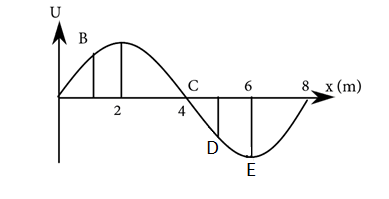
Potential energy curve is shown in figure. Point at unstable equilibrium is:

(A) \[x = 6\]
(B) \[x = 4\]
(C) \[x = 2\]
(D) \[x = 3\]
Answer
219.3k+ views
Hint: An object is in equilibrium when the net force on it is zero. The force on a body can be given as the negative of the gradient of the potential energy. Unstable equilibrium occurs when a slight displacement will cause a decrease in potential energy.
Formula used: In this solution we will be using the following formulae;
\[F = - \dfrac{{dU}}{{dx}}\], where \[F\] is the force acting on a body, \[U\] is the potential energy of the body, and \[x\] is the position of the body.
\[\dfrac{{dU}}{{dx}}\] signifies an instantaneous rate of change of potential energy with distance (called gradient).
Complete Step-by-Step Solution:
A graph of potential energy with distance is given, and we are to find the point of unstable equilibrium.
Generally, we know that equilibrium exists where the sum of the forces acting on a body is zero. Hence we need first to identify the point of zero net force.
The force acting on a body can be given as
\[F = - \dfrac{{dU}}{{dx}}\], where \[F\] is the force acting on a body, \[U\] is the potential energy of the body, and \[x\] is the position of the body.
Hence, if \[F\] is zero, then \[\dfrac{{dU}}{{dx}} = 0\] i.e. the slope of the graph given is zero.
This occurs at a point where the tangent to the curve would be horizontal. And this occurs at point 2 and 6 in the curve given.
Now, the point of unstable equilibrium occurs at the maximum point of the curve (where the gradient is zero) which corresponds with point 2.
Hence, the correct option is C
Note: For clarity, unstable equilibrium corresponds to the maximum point because although the force at such point may be zero, any slight displacement will tend to reduce the potential energy of the body and hence the body continues to move (which is the description for unstable equilibrium). And generally, the potential energy of the body in any field whatsoever always tends towards the minimum.
Formula used: In this solution we will be using the following formulae;
\[F = - \dfrac{{dU}}{{dx}}\], where \[F\] is the force acting on a body, \[U\] is the potential energy of the body, and \[x\] is the position of the body.
\[\dfrac{{dU}}{{dx}}\] signifies an instantaneous rate of change of potential energy with distance (called gradient).
Complete Step-by-Step Solution:
A graph of potential energy with distance is given, and we are to find the point of unstable equilibrium.
Generally, we know that equilibrium exists where the sum of the forces acting on a body is zero. Hence we need first to identify the point of zero net force.
The force acting on a body can be given as
\[F = - \dfrac{{dU}}{{dx}}\], where \[F\] is the force acting on a body, \[U\] is the potential energy of the body, and \[x\] is the position of the body.
Hence, if \[F\] is zero, then \[\dfrac{{dU}}{{dx}} = 0\] i.e. the slope of the graph given is zero.
This occurs at a point where the tangent to the curve would be horizontal. And this occurs at point 2 and 6 in the curve given.
Now, the point of unstable equilibrium occurs at the maximum point of the curve (where the gradient is zero) which corresponds with point 2.
Hence, the correct option is C
Note: For clarity, unstable equilibrium corresponds to the maximum point because although the force at such point may be zero, any slight displacement will tend to reduce the potential energy of the body and hence the body continues to move (which is the description for unstable equilibrium). And generally, the potential energy of the body in any field whatsoever always tends towards the minimum.
Recently Updated Pages
Two discs which are rotating about their respective class 11 physics JEE_Main

A ladder rests against a frictionless vertical wall class 11 physics JEE_Main

Two simple pendulums of lengths 1 m and 16 m respectively class 11 physics JEE_Main

The slopes of isothermal and adiabatic curves are related class 11 physics JEE_Main

A trolly falling freely on an inclined plane as shown class 11 physics JEE_Main

The masses M1 and M2M2 M1 are released from rest Using class 11 physics JEE_Main

Trending doubts
JEE Main 2026: Application Form Open, Exam Dates, Syllabus, Eligibility & Question Papers

Understanding Uniform Acceleration in Physics

Derivation of Equation of Trajectory Explained for Students

Hybridisation in Chemistry – Concept, Types & Applications

Understanding the Angle of Deviation in a Prism

Understanding Collisions: Types and Examples for Students

Other Pages
JEE Advanced Marks vs Ranks 2025: Understanding Category-wise Qualifying Marks and Previous Year Cut-offs

Units And Measurements Class 11 Physics Chapter 1 CBSE Notes - 2025-26

NCERT Solutions For Class 11 Physics Chapter 8 Mechanical Properties Of Solids

Motion in a Straight Line Class 11 Physics Chapter 2 CBSE Notes - 2025-26

NCERT Solutions for Class 11 Physics Chapter 7 Gravitation 2025-26

Understanding Atomic Structure for Beginners




